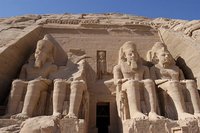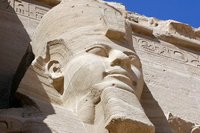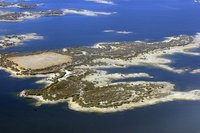Abu Simbel
|
|
The archaeological complex of Abu Simbel comprises two massive rock temples in southern Egypt, built on the western bank of the River Nile - presently, Lake Nasser. It is a part of the Nubian Monuments UNESCO World Heritage Site, which runs from Abu Simbel downriver as far as Philae.
The twin temples were carved out of the mountainside by Pharaoh Rameses II in the 13th century BC to intimidate his Nubian neighbors and as a lasting monument to himself and his queen Nefertari, commemorating his alleged victory at the Battle of Kadesh.
| Contents |
The Greater Abu Simbel Temple
The Greater Abu Simbel Temple, one of many relics erected by Pharaoh Rameses II, is generally considered the grandest and most beautiful of his temples. The facade is 33 meters high, and 38 meters broad, and guarded by four statues of Rameses II, each of which is 20 meters high.
High on the facade, there is a carved row of baboons, smiling at the sunrise. On the doorway of the temple, there is a beautiful inscription of the king's name, Ser-Ma'at-Ra, and between the legs of the colossal statues on the fa硤e there are smaller statues of Rameses II's family: his mother Mut-tuy, his wife Nefertari, and his sons and daughters.
There is also a number of dedications, most notably one that records Rameses II's marriage to the daughter of the King of the Hittites. The temple entrance leads on to the Great Hall of Pillars, with eight pillars bearing the deified Rameses II in the shape of Osiris.
The walls of this hall bear inscriptions recording the Battle of Kadesh waged by Rameses II against the Hittites. Then we enter the smaller hall of the temple – the hall of the nobles, containing four square pillars. Then we come to the Holiest of Holies, containing four seated statues of Ra-Harakhte, Ptah, Amun-Ra, and the deified Rameses II. This temple is unique, since the sun shines directly on the holy of holies two days a year: February 21, the king's birthday, and October 22, the date of his coronation.
The Smaller Abu Simbel Temple
The Smaller Abu Simbel Temple is located north of the Greater Temple. It was carved in the rock by Rameses II and dedicated to Hathor, the goddess of love and beauty, and also to his favorite wife, Nefertari. The fa硤e is adorned by six statues, four of Rameses II and two of Nefertari; most unusually, the six are the same height, which indicates the esteem in which Nefertari was held. The entrance leads to a hall containing six pillars bearing the head of the goddess Hathor.
The eastern wall bears inscriptions depicting Rameses II striking the enemy before Ra-Harakhte and Amun-Ra. Other wall scenes show Rameses II and Nefertari offering sacrifices to the gods.
Beyond this hall, there is another wall with similar scenes and paintings. In the farthest depths of the temple is the holy of holies, where a statue of the goddess Hathor stands.
This is, indeed, a most awesome sight to the visitor; for here he finds the greatest artificial dome that bears the man-made mountain behind the Temples of Abu Simbel.
Relocation
Model showing the relative positions of the Abu Simbel temples before and after relocation]]In 1959 an international donations campaign to save the monuments of Nubia began: the southernmost relics of this ancient human civilization were under threat from the rising waters of the Nile that were about to result from the contruction of the Aswan High Dam. The salvage of the Abu Simbel temples began in 1964, and cost some USD $36 million. Between 1964 and 1968, the entire site was dismantled and reassembled in a new location – 65 m higher and 200 m back from the river.
Pictures of Abul Simbel
- Abu Simbel Pictures (http://classroomclipart.com/cgi-bin/kids/imageFolio.cgi?direct=Countries_and_Cities/Egypt/Abu_Simbel)




